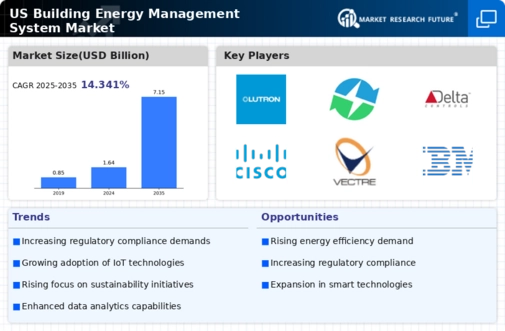Rising Energy Costs
The building energy-management-system market is experiencing a notable surge due to the rising energy costs in the United States. As energy prices continue to escalate, businesses and organizations are increasingly seeking solutions to optimize their energy consumption. This trend is particularly evident in commercial buildings, where energy expenses can account for a significant portion of operational costs. According to recent data, energy costs for commercial buildings have risen by approximately 15% over the past five years. Consequently, the demand for energy management systems that can provide real-time monitoring and analytics is likely to grow, as stakeholders aim to reduce their energy bills and enhance overall efficiency.
Increased Regulatory Pressures
Increased regulatory pressures are shaping the landscape of the building energy-management-system market. As governments implement stricter energy efficiency standards and regulations, organizations are compelled to adopt energy management solutions to remain compliant. These regulations often mandate specific energy performance benchmarks, which can only be met through effective energy management practices. the building energy management system market will benefit from this trend, as companies seek to avoid penalties and enhance their compliance strategies. Furthermore, organizations that proactively adopt energy management systems may find themselves at a competitive advantage, as they can demonstrate their commitment to regulatory compliance and sustainability.
Government Incentives and Support
Government incentives and support are significantly influencing the building energy-management-system market. Various federal and state programs are designed to promote energy efficiency and sustainability in buildings. For instance, tax credits, rebates, and grants are available for organizations that implement energy management systems. These incentives not only reduce the initial investment costs but also encourage long-term commitment to energy efficiency. Recent reports indicate that buildings utilizing energy management systems can achieve energy savings of up to 30%, making them more attractive to property owners. As awareness of these incentives grows, the market is likely to see increased participation from businesses looking to capitalize on available financial support.
Growing Focus on Environmental Responsibility
The growing focus on environmental responsibility is driving the building energy-management-system market. As climate change concerns intensify, organizations are increasingly prioritizing sustainability in their operations. This shift is prompting businesses to adopt energy management systems that not only reduce energy consumption but also minimize their carbon footprint. The building energy-management-system market is responding to this demand by offering solutions that align with corporate sustainability goals. Companies that implement these systems often report enhanced brand reputation and customer loyalty, as consumers are more inclined to support environmentally responsible businesses. This trend is expected to continue, further propelling the market forward.
Technological Advancements in Energy Management
Technological advancements are playing a crucial role in shaping the building energy-management-system market. Innovations such as artificial intelligence, machine learning, and advanced data analytics are enabling more sophisticated energy management solutions. These technologies allow for predictive maintenance, automated energy optimization, and enhanced user interfaces, making energy management more accessible and effective. The integration of smart sensors and IoT devices is also facilitating real-time data collection and analysis, which is essential for informed decision-making. As these technologies continue to evolve, they are expected to drive further adoption of energy management systems across various sectors, including commercial and industrial buildings.

















Leave a Comment